MIRACULOUS ICONS
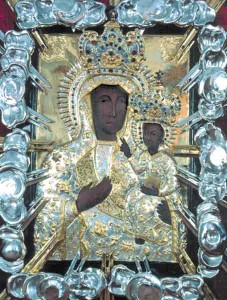
Ulashkiv Icon of the Mother of God (XVII century)
According to legend, the history of the Ulashkiv Miraculous Icon of the Mother of God dates back to the second half of the seventeenth century. Numerous miraculous healings that took place near this image of the Blessed Virgin Mary, as well as the miraculous protection of the inhabitants of the region from the raids of the cruel hordes on villages and towns, are documented in the chronicle of the Ulashkiv Monastery of 1678. The inhabitants of the region, in times of trouble, suffering, and attacks by the Tatar-Turkish conquerors, always came to this icon of the Mother of God with prayer and received relief, gained strength not to break down, not to despair, but to withstand and defend their native land.
Although the monastery itself was repeatedly destroyed and plundered by the infidels, the icon of the Blessed Virgin Mary miraculously remained intact. In 1740, the monastery was robbed, but this time not by Tatars or Turks, but by Russian troops. All the valuable church property (manuscripts, books, liturgical items, and all the icons) was taken away. The miraculous icon of the Blessed Virgin Mary did not disappear without a trace. It was probably bought back by someone. More than two decades later, it returned to the monastery. The icon of the Blessed Virgin Mary was donated in 1765 by the Ukrainian noble family of Dobrynsky-Ratiborsky.
Having received a decision from a special commission based on the relevant and sworn testimonies of eyewitnesses to the miracles that occurred at this icon of the Mother of God, Bishop Lev Sheptytsky proclaimed the Ulashkiv icon “grace-filled,” that is, miraculous, by a letter of October 4, 1773. In 1774, through the efforts of the monks of the Ulashkiv monastery, silver gilded vestments were made for the miraculous icon of the Mother of God with donations from pious countrymen. In 1868, this miraculous icon was moved from the old monastery church to the modern stone church of the Nativity of the Blessed Virgin Mary in Ulashkivtsi. Since then, the Ulashkivtsi Monastery has become the largest pilgrimage site in the Ukrainian region called Galician Podillia.
During the Soviet Communist regime, the miraculous icon of the Mother of God was kept in the parish church of Ulashkivtsi because the monastery was destroyed and the monastery church was in a very poor state of repair. Thanks to the intercession of the Mother of God, the faithful found relief and intercession before God at the miraculous icon of the Blessed Virgin Mary of Ulashkiv.
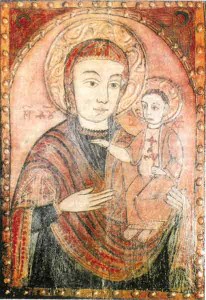
Mariapocs Icon of the Mother of God (XVII century)
The history of this miraculous icon of the Blessed Virgin Mary dates back to 1676, when, according to the monastery chronicle, a resident of the village of Pocs, Lavrentii Hurta, bought the icon from an iconographer and presented it to the local church.
20 years later, on November 4, 1696, on Sunday, during the Divine Liturgy after the consecration of the Holy Gifts, the faithful present at the service saw tears in the eyes of the Mother of God, who is depicted in this icon. Mykhailo Evri was the first to notice the tears on the icon of the Mother of God. The Blessed Virgin Mary depicted on the icon cried intermittently until December 8 of the same year. Numerous miracles were performed near this icon during those days. Based on the conclusions of church and secular commissions, the Mariapocs Icon of the Blessed Virgin Mary was officially recognized as miraculous. In 1697, by order of the Austrian Emperor Leopold I, this icon was moved to Vienna, where it was placed in the Cathedral of St. Stephen and is still kept in this city.
An unknown iconographer from Kosice painted three copies of this miraculous icon of the Mother of God. One of them was given back to the church in the village of Pocs, which was named Mariapocs because of numerous miracles through the mediation of the Mother of God. This copy of the miraculous icon of the Blessed Virgin Mary also wept during the Divine Liturgy in 1715. The second weeping lasted intermittently from August 1 to 5. Once again, the relevant commissions, both church and secular, consisting of scholars from various fields of science, recognized that a supernatural force was at work here as well. On August 25, 1715, a copy of the Mariapocs Icon of the Mother of God was proclaimed miraculous by Bishop A. Ardeli. Pope Pius VI granted the church of Mariapocs Plenary indulgence.
In 1756, the miraculous Mariapocs Icon was moved to the newly built church of the Mariapocs Basilian Monastery. For the third time, the Mariapocs Icon wept intermittently from December 3 to 19, and then from December 30 to 31, 1905. The fourth time the icon wept was in 1917. Records of the numerous miracles that took place through the mediation of the Mother of God at this miraculous icon were kept in the chronicle of the monastery church.
In the early postwar years, the miraculous icon was restored. During its restoration, it turned out that the icon of the Blessed Virgin Mary was a perfect copy of a valuable monument of Byzantine iconography.
The festal celebrations with the participation of many thousands of pilgrims, and numerous gold and silver votive pieces are the best proof that the Blessed Virgin Mary, depicted on the Mariapocs Miraculous Icon, listens to the prayers of her children and beseeches God for numerous graces and healings.
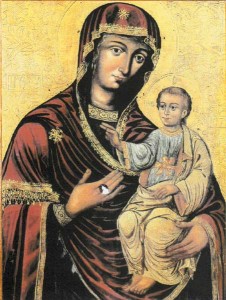
Pohonya Icon of the Mother of God (XVII century)
The story of the appearance of the miraculous icon in Pohon is shrouded in many legends. It was painted by an unknown author no later than 1650. In 1736, a new church of the Assumption of the Blessed Virgin Mary was built in the monastery in gratitude for the gifts of healing received at this icon, with donations from noblewomen Ivanna Velyhorska of Potocki and Sofia Zagvoyska of Uhrynska. Thousands of pilgrims came to the shrine. In the seventies of the seventeenth century, silver gilded vestments and crowns were made with their donations in gratitude for the favors received. However, during the church reform of Emperor Joseph II, the precious vestments and crowns were removed, as well as all the votive items that adorned the icon.
On the basis of the decision of the Spiritual commission, Bishop Athanasius Sheptytsky declared the icon miraculous. By a decree of Pope Pius X of June 9, 1908, the main altar of the monastery church of the Assumption of the Blessed Virgin Mary was granted four indulgenced holy days per year.
In the early twentieth century, a new monastery church was built. However, in 1946 the monastery was liquidated by the Soviet authorities. It was first used as a boarding school for mentally disabled children, and the church was destroyed in 1950. Much of the property of the monastery church, perhaps including the miraculous icon, was transferred to the parish church of the village of Pshenychnyky near Pohonya. The miraculous icon had several copies. One of them was hidden at home by pious residents from different villages. The last place where this copy was hidden was the village of Dora, near Yaremche. On May 26, 1996, this icon was solemnly transferred to the newly built chapel on the territory of the monastery in Pohonya. However, the search for the original miraculous icon continued. On March 6, 2001, the then superior of the monastery in Pohonya, Father Nikodym Huraliuk, was praying and looking at another icon of the Virgin Mary in a very poor condition, which had been returned from Pshenychnyky in the 1980s. As the specialists of the Ukrzakhidproektrestavratsiya institute later confirmed, it was the original.
In 1992, the miraculous icon was transferred to a newly built chapel on the territory of the Basilian monastery in Pohonya. After the restoration, on June 27, 2001, the icon was blessed by His Holiness Pope John Paul II. Then the icon was returned to the monastery church in Pohonya.
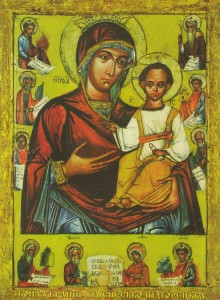
Pidhirtsi Icon of the Mother of God (16th century)
Since 1688, the monastery has been in charge of the Church of the Nativity of the Blessed Virgin Mary in the village of Holubytsi, where the miraculous icon first appeared. The monastery chronicle of 1699 contains the first written mention of the icon of the Virgin Mary, before which miracles took place for several months in 1692: the image of the Blessed Virgin wept tears, candles that had not been lit by anyone lit several times near this icon, many sick people who came to this holy image in faith were healed of various ailments, according to their request.
By a letter of April 14, 1694, Bishop Joseph Shumliansky of Lviv proclaimed the icon miraculous. On April 17 of the same year, it was solemnly transferred from the parish church in Holubytsia to the Pidhirtsi monastery in an old church, and later to the new monastery church of the Annunciation of the Blessed Virgin Mary. In gratitude for the numerous miracles, in 1715, silver gilded vestments were made for the icon, and 39 years later the icon was crowned by Pope Benedict XIV.
After the closure of the Pidhirtsi Monastery by the Soviet authorities, the icon and the votive gifts were kept by the faithful of the villages of Pidhirtsi and Plisnesk. On April 7, 1991, with the restoration of the monastery, the icon was returned to the Church of the Annunciation of the Blessed Virgin Mary, and in the late 1990s it was restored.
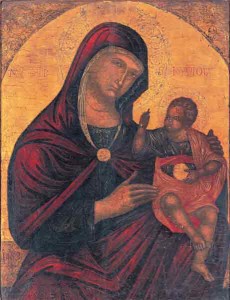
Mukachevo Icon of the Mother of God (15th century)
According to ancient tradition, the Mukachevo Monastery of St. Nicholas was founded before 1242. Over the centuries, it was destroyed three times and rebuilt three times. Since 1733, the Mukachevo Monastery was the seat of the Protohegumen of the Province of St. Nicholas of the Basilian Fathers in Transcarpathia, and in the 1920s it became the center of renewal of the monastic life of the Basilian Order in the “Silver Land.” It was at this time, in 1926, that Pope Pius XI presented the Mukachevo Monastery with a miraculous icon of the Blessed Virgin Mary. This icon was painted in the fifteenth century and possibly came from Constantinople. After the fall of Constantinople, the icon was transported to Rome. On June 27, 1926, on the Sunday of All Saints, the icon was solemnly transferred to the Church of St. Nicholas on Chernecha Hill. At that time, the entire Transcarpathian region was consecrated to the care of the Blessed Virgin Mary.
When Soviet power came to Transcarpathia, the monastery was liquidated. In 1947, the monks were forcibly removed from the monastery. The miraculous icon was saved from destruction: it was first hidden in the village of Svaliava, and later by a family from Mukachevo. In 2000, the Mukachevo Miraculous Icon of the Blessed Virgin Mary was transferred to the Basilian Church of the Holy Spirit in the village of Malyi Bereznyi. This monastery celebrates the feast of the Descent of the Holy Spirit and the feast of the Transfiguration of the Lord.
After the Basilian Fathers resumed their ministry in Mukachevo, the Monastery of St. Nicholas was founded on a new site. On July 16, 2009, the Mukachevo Miraculous Icon of the Blessed Virgin Mary was solemnly transferred here. With the blessing of the Dicastery for the Eastern Churches, a separate holiday was established on July 16 to honor the Mukachevo Miraculous Icon of the Blessed Virgin Mary; since 2010, it has been proclaimed an eparchial holiday in the Mukachevo Greek Catholic Eparchy, which is celebrated annually on July 16 in the Mukachevo Basilian Monastery of St. Nicholas. In addition, this monastery holds a vigil for the feast of the Assumption of the Blessed Virgin Mary on August 28.
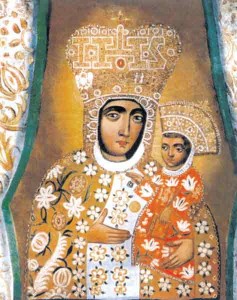
Krystinopil icon of the Mother of God (XVIII century)
The miraculous icon together in 1765 was presented to the monastery church by Stanislav Kostka-Sadovsky, a marshal of the court of Count of Silesia Potocki. While in the Monastery Church, the icon became a mediator for the generous graces of God. Thus, according to records in the monastery books, in addition to a number of descriptions of healing and assistance in various life difficulties, there is a mention of the cholera epidemic, which struck the outskirts of Krystinopil in 1770. In order to stop its spread, the monks with the faithful made a prayer march around the city with the miraculous icon. The epidemic did not reach Krystinopil. The following year, on the basis of the decision of the spiritual commission, Bishop Maximilian Rylo, with his decree of January 26, 1771, proclaimed the Krystinopil icon miraculous.
In 1773, the Basilian monks, as a sign of gratitude for the care of the Blessed Virgin Mary, made silver robes and gold crowns for the miraculous icon. Indulgenced feastday celebrations in Kristinopil took place according to the decree of Pope Leo XIII from 1902 – on the holiday of St. Onufrius and on all the feasts of the Mother of God.
After the Second World War, when the Soviet authorities took power over the city, on June 17, 1947, the Basilian fathers were forcibly expelled from the monastery. The miraculous icon was transported to Warsaw by Father Arsenius and two Basilian brothers-Benjamin and Hyacinthe. Initially, the Krystinopil icon was in the chapel of the novitiate home of the Sister-Servants, and a little later-in the chapel of the Monastery of the Basilian Fathers. In 1994, on the Feast of the Annunciation, the miraculous icon was solemnly returned to the Chervonohrad Monastery Church of St. George.
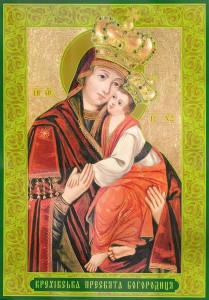
Verkhratsk icon of the Mother of God (XVII century)
The name of the icon comes from the village of Verkhrat-located on the Rat River, which belongs to the ancient settlements of the times of Kyiv Rus, and later-the Galicia-Volyn principality. The history of the Verkhrat miraculous icon of the Virgin, begins with the city of Zamosc. In 1682, the superior of the Verkhrat monastery, Father Isaac Sokalsky brought this icon to the monastery. And after 6 years – in 1688, on the feast of the Deposition of the Robe of the Blessed Virgin, the first miracles began. In the middle of the night, a fiery pillar appeared above the monastery that illuminated the entire neighborhood. People from the surrounding villages ran to see this miracle, and when under the leadership of a priest, they entered the church, they saw a light burning in front of the icon of the Virgin, and bloody tears flowed on the face on the icon of the Mother of God from her eyes. This lasted for four weeks. And people began to come to the icon in the Verkhrat Monastery with their illnesses and troubles, asking for help from the Heavenly Mother. All miracles that took place near the icon were described and confirmed by witnesses under the oath. In the same year, Bishop Joseph Shumlyanski of Lviv, having come to Verkhrat and having seen the icon upon which bloody tears flowed, heard witnesses and proclaimed the Verkhrat icon of the Blessed Virgin Mary to be miraculous.
With the abolition of the Basilian monastery in Verkhrat, in 1808 the icon was solemnly transferred to the Basilian monastery in Krekiv. Miracles continued here.
After closing the monastery in Krekhiv, the miraculous icon was transferred to the Lviv Church of St. Paraskevia Friday. With the emergence of the Ukrainian Greek Catholic Church from the underground, the Verkhrat miraculous icon of the Blessed Virgin Mary was returned to Krekhiv on May 19, 1991, from the church in Lviv.
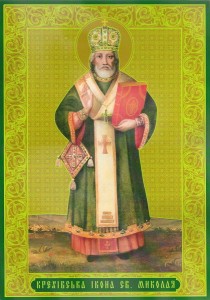
Krekhiv icon of St. Nicholas (XVII century)
According to one version, the place of origin of the icon of St. Nicholas of Myra-Lycia is Belarus, from where one of the founders of the monastery, Joel, brought it. Mention of pilgrimages to the miraculous icon in the Krekhiv Monastery date from the XVII-XVIII centuries. It is known that pilgrims from various places in Ukraine came here, as well as from Greece and Crete. In the XVIII century, the icon was clothed in silver-gilded vestments as a sign of gratitude for protection. However, due to the fact that the vestments had a bad effect on the state of the icon, in 2002 they was removed and the icon was restored.
Pilgrimages on the feast of the Translation of the Relics of St. Nicholas, May 18, were very numerous. For example, in 1910, about 60 thousand pilgrims came to the Krekhiv shrine, in 1912 – about 80 thousand, and in 1927 – up to 70 thousand people.
With the closure of the Krekhiv Monastery, the miraculous icon was hidden by one of the monks, Anthony, in his apartment. When there was a danger of losing the icon due to frequent monitoring of the monk by the Soviet security agencies, the icon was taken for safe-keeping to the Church of the Assumption of the Blessed Virgin in Lviv. On December 23, 1990, the miraculous icon of St. Nicholas of Myra-Lycia was solemnly transferred from Lviv to the Krekhiv Monastery.
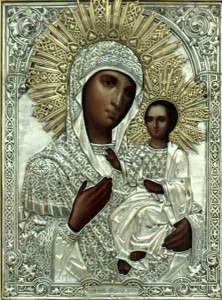
The Vitsyn Icon of the Mother of God (17th century)
The miraculous icon, which is now housed in the Basilian Monastery in Krasnopuscha, is associated with a monastery in the village of Vitsyn, near the city of Przemyslian (Ukraine). Since the first half of the eighteenth century, the Basilian Monastery of the Nativity of the Blessed Virgin Mary in Vitsyn has been a well-known pilgrimage center thanks to this miraculous icon.
This miraculous icon is a copy of the Iver Icons of the Virgin Mary that are widespread in Ukraine. According to legend, in the days of iconoclasm, a woman from Iver (Georgia) threw the icon into the sea to avoid desecration of the shrine, which was highly revered in her home. Subsequently, this icon was found in great radiance on the shore near Mount Athos. There it remained, guarding the monastery and granting many favors.
The miraculous icon was donated to the Vitsyn Monastery by a noblewoman, Anastasia Mykula. At that time, it was already decorated with nine silver votive gifts. By a letter dated September 21, 1706, Bishop Joseph Shumlansky proclaimed the Vitsyn Icon of the Blessed Virgin Mary to be miraculous. In 1846, a large fire destroyed the monastery, but the icon remained intact. The Vitsyn monastery was liquidated, and the miraculous icon was transferred to the Monastery of St. Onufriy in Lviv.
In 1934, the icon was solemnly transferred to the Basilian Monastery of St. John in Krasnopuscha. Every year, crowded pilgrimages were held here for the feast of the Nativity of St. John the Baptist and for all the feasts of the Virgin Mary. With the advent of communist rule, the monastery in Krasnopushcha was liquidated. The miraculous icon was saved from destruction by the local church cantor. Later it was kept in the house of his sister. With the restoration of the monastery, she returned it to the Basilian Fathers for public veneration.
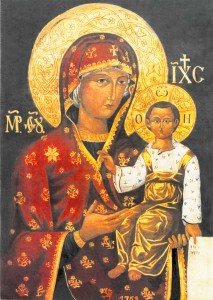
Krasnobrodska icon of the Mother of God (XIV century)
The first information about the Krasnobrida Miraculous Icon of the Blessed Virgin Mary comes from a folk legend from the second half of the 14th century, recorded in the pages of the monastery chronicle. A blind man traveling in that region washed his face with water from a well and, having prayed sincerely to the Mother of God, received his sight. As a sign of gratitude for his miraculous healing, he built a small chapel near the well, where he placed an icon of the Blessed Virgin Mary.
Since then, numerous pilgrims from all over the Galician Lemkivshchyna and northeastern Slovakia have gathered here. A wooden church and cells for several monks were built here at the expense and effort of Prince Fedir Koryatovych as a sign of sincere gratitude to the Mother of God for her care for the region. In 1603, the Krasnobrida Basilian Monastery suffered greatly from fire and robbery, but this icon of the Blessed Virgin Mary remained miraculously intact.
Already in the early 60s of the seventeenth century this icon was widely known in the region for its miracles. The faithful began to decorate the miraculous icon of the Blessed Virgin Mary with numerous votive gifts as a sign of gratitude to the Lord for the favors that, through the intercession of the Mother of God, descended on pious pilgrims who came to this miraculous icon at Krasnobrida with faith and hope.
From the second half of the eighteenth century, despite difficult times, the Krasnobrida Monastery continued to be an important place of pilgrimage. Pious pilgrims from all over the region gathered here for giant pilgrimages on the feasts of the Descent of the Holy Spirit and the Protection of the Mother of God to receive healing from bodily and mental ailments before the miraculous icon of the Blessed Virgin Mary. In 1761, a new monastery church with a chapel was built here, in which the miraculous icon of the Mother of God was placed.
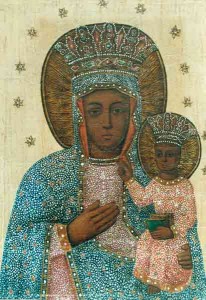
The Hoshiv icon of the Mother of God (XVIII century)
The Hoshiv Miraculous Icon of the Blessed Virgin Mary is a copy of the miraculous Belz (Czestochowa) icon of the Virgin Mary, which was famous for its miracles in the Belz Castle chapel from the 14th century. At the end of that century it was transported to Poland, to the town of Czestochowa. Information about the miraculous copy dates back to the first half of the eighteenth century. It was kept in the house of a nobleman, Andrii Shuhai, from the village of Khorobriv in the Ternopil region. One day, during a fire that destroyed the nobleman’s house, the wall on which the icon hung miraculously survived. This miraculous incident gave rise to a belief in the icon’s miraculous power and increased its veneration in the Shuhai family. Later, when Khorobriv was threatened by peasant riots, Shuhay’s daughters moved to the village of Dunayiv in the Peremyshlyany region to live with the Hoshovsky family and took the icon with them. When they returned home to Khorobriv, Andrii Shuhai presented the icon to the Hoshovsky family in gratitude for sheltering his daughters in their time of need.
In 1736, the face of the Virgin Mary on the miraculous icon was covered with small drops of dew, as if with sweat, and tears flowed from her eyes. Hoshovsky then transferred the icon to the Roman Catholic Church in Dunayiv for veneration. For a year, the miraculous icon was kept in the church’s sacristy and was not available for public veneration because the church already had two miraculous icons, the Icon of Christ and of the Suffering Mother of God. Hoshovsky was not satisfied with this state of affairs, and he appealed to Metropolitan Athanasius Sheptytsky of Lviv to recognize the icon as miraculous. The icon was moved from the church to Hoshovsky’s estate in Hoshiv.
After hearing testimonies, the icon was recognized as miraculous by Bishop Athanasius Sheptytsky’s letter of July 11, 1737. On August 5 of the same year, the icon was solemnly transferred to the monastery church on Yasna Hora. On the same day, a miracle occurred, which was first recorded in the monastery chronicle: “A day earlier, a resident of the village of Semyhinova in Stryi district, Kunekunda Sadovska, recovered by the grace of the Virgin Mary. The day before, on August 4 (Saturday), her husband attended the evening service in the village church, during which the priest said that tomorrow the miraculous icon would be transferred and installed in the monastery church on Yasnaya Gora. Moved by what he heard, Matej Sadovsky came home and, looking at his sick wife, whose death the family was expecting from day to day, fell to the ground in the form of a cross, in despair, and began to beseech with all his heart for Our Lady of Hoshiv to help his wife. And Matei’s prayers were answered. His wife opened her eyes and got out of bed. The next day, when the icon was being transferred to the monastery church, the happy couple came to Hoshiv and the healed woman related her miraculous recovery under oath.”
Later, when the monastery was moved to Yasna Hora, the icon was placed behind the main altar. With the liquidation of the monastery in Hoshiv, the monks secretly handed over the miraculous icon to the residents of Hoshiv. On October 14, 2001, after solemn processions through the cities and numerous villages of the Ivano-Frankivsk and Lviv regions, the icon returned to Yasna Hora.
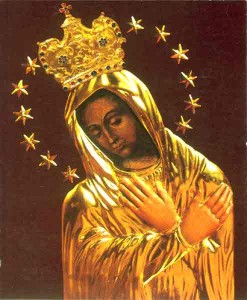
Derevnyanska Icon of the Mother of God (XVII century)
The history of the icon began in 1786 in the village of Derevnya. One couple had not had children for a long time, but they prayed tirelessly before the icon of the Mother of God so that the Lord would give them a child. A boy was born. But it turned out that the child was blind. For five years, the parents prayed fervently before the icon, begging the Mother of God to help the child see. On the feast of the Assumption of the Blessed Virgin Mary, the mother told her son about the Mother of God. And at some point the child exclaimed, looking at the icon of the Mother of God: “How beautiful is the Mother of God!” The boy could see. The consoled parents gave the icon for public veneration to the Basilian monastery in Zhovkva, where its veneration as a miraculous icon began, and it remained there until 1948, when the monastery was closed by the Soviet authorities.
With the closure of the Zhovkva monastery on the feast of the Annunciation, the icon was secretly transported to Krekhiv. But soon after, on the feast of the Assumption of the Virgin, the monastery in Krekhiv was also closed, and the church’s belongings and icons were threatened with destruction. The miraculous icon from Derevnya miraculously survived and came to the Basilian monk Anthony Masyuk. Thanks to his prayers in front of this miraculous icon of the Suffering Mother of God, a terminally ill girl, the daughter of a local atheist, was healed on the Feast of the Annunciation.
After that, the icon of the Suffering Mother of God was kept in the Basilian monastery in the village of Malekhiv. On January 18, 1990, the icon was moved to the restored monastery church of St. Onufriy in Lviv. At the end of the same year, it was moved to the Lviv Church of St. Andrew the First-Called. Since 1997, the icon was kept in the Basilian Church of the Sacred Heart of Christ in Zhovkva, and in 1999 it was returned to the Church of St. Andrew the First-Called.
On June 27, 2001, the Derevnyany Miraculous Icon of the Mother of God was crowned by His Holiness Pope John Paul II during a Divine Liturgy in Lviv.
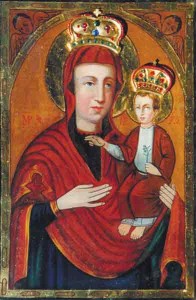
Boroniavo Icon of the Mother of God (XVII century)
The first mention of the Boroniavo Miraculous Icon of the Blessed Virgin Mary is found in the monastery chronicle of 1785. Father Ioanikii Bazylevych, later the provincial superior, painted an icon of the Blessed Virgin Mary on canvas. He was prompted to paint this icon by the story and oath of two eyewitnesses who saw the apparition of the Mother of God near the Boroniavsky monastery. On the feast of the Annunciation of the Blessed Virgin Mary, the icon was blessed and placed in the iconostasis in the monastery church.
After some time, miracles began to occur near the icon, and at the end of the eighteenth century, by the decision of the relevant commission, it was recognized as miraculous. By the decree of Pope Leo XIII of March 28, 1893, the icon was crowned, and the monastery was granted the right to hold pilgrimages three times a year: on the Annunciation of the Blessed Virgin Mary, the Holy Prophet Elijah, and the Exaltation of the Holy Cross. Ukrainians, Czechs, Hungarians, and Romanians came to the miraculous icon in Boroniava.
Under Soviet rule, when the monastery was closed, the icon was kept in the homes of pious people. And on April 8, 1991, the miraculous icon was solemnly transferred from the city of Khust to the church in the Boroniavo Monastery.
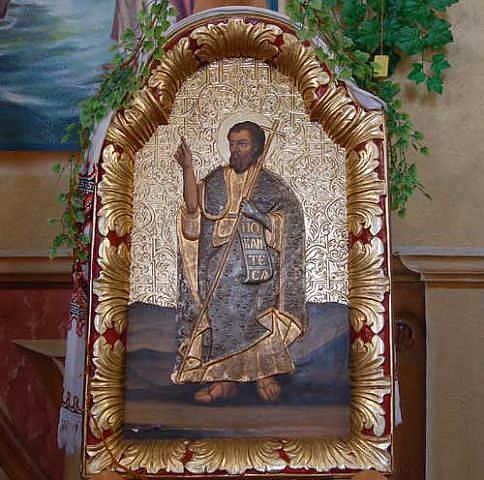
Ulashkivtsi Icon of St. John the Baptist
Tradition says that this icon was brought by several monks in 1315 who settled in limestone caves in the village of Ulashkivtsi (Ukraine). It is because of the miraculous icon that the village of Ulashkivtsi became a famous place of pilgrimage because the news of the Basilian monks and the icon of St. John was spread throughout Europe by merchants. Ulashkivtsi was a town that stood on the trade route from the Baltic Sea to the Black Sea, and from East to West. Later on, large fairs were organized here, bringing together merchants from Greece, Wallachia, Turkey, Germany, and Czechia.
The icon was originally kept in the cave chapel of St. John. In 1673, the future Polish king Jan Sobieski III and his army prayed there. In addition, a figure of St. John the Baptist once stood in the rock above the chapel, from under which water flowed, which, according to pilgrims, helps with eye diseases. It is also known that in 1775 the vestments of the icon of St. John the Baptist were restored.
It is known that the piety of the people to the Ulashkivtsi Miraculous Icon of St. John the Baptist was unusually great. This is clearly evidenced by the monastery’s pilgrimages in honor of the Holy Forerunner. The oldest and greatest eight-day pilgrimage is on the Feast of the Nativity of St. John the Baptist on July 7. The right to hold this eight-day pilgrimage was granted by Metropolitan Athanasius Sheptytsky in 1738. Another pilgrimage in honor of John the Baptist was held on the feast of the Beheading of John the Baptist.
For several decades of Soviet rule, the Ulashkivtsi Monastery was in ruins and oblivion, and the monks were mostly sent to prisons and labor camps in Siberia. However, 1990 gave new life to the monastery. Basilian monks returned here and, with the help of parishioners, restored the monastery and church. An icon of St. John the Baptist was also found in a bad condition and restored in May 1997.
Today, pilgrimages to the monastery are held annually on various holy days, but the biggest one, as it was before, is the feast of the Nativity of St. John the Baptist.

 Basilian Order of Saint Josaphat
Basilian Order of Saint Josaphat 

